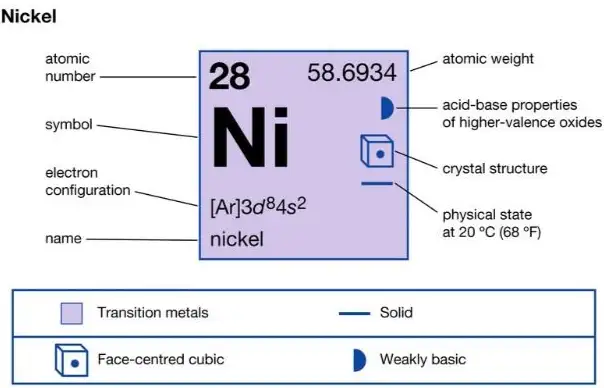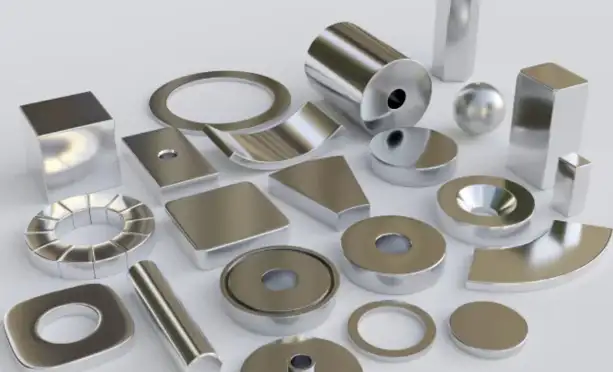Is nickel magnetic? Yes! nickel is magnetic, it belongs to the exclusive class of elements—alongside iron, cobalt, and gadolinium—that exhibit ferromagnetism at ambient conditions. This means that pure nickel reacts strongly to magnetic fields and can itself be magnetized. Its intrinsic magnetism arises from unpaired electrons in 3d orbitals and a crystalline arrangement that permits magnetic-domain alignment. However, its behavior changes with temperature and chemical composition, so the magnetic character may be altered in alloys or at elevated temperatures.
Atomic Structure and Electronic Configuration
Pure nickel (atomic number 28) has the electron configuration [Ar] 3d⁸ 4s², leaving two unpaired electrons in the 3d shell. These unpaired electrons create discrete magnetic dipoles—each atom acting like a tiny magnet. When these dipoles align under appropriate conditions, a collective magnetic behavior emerges.
Ferromagnetism and Magnetic Domains
Ferromagnetism is a special form of magnetism arising when atomic moments align preferentially in parallel via quantum mechanical exchange interactions. Nickel’s face-centered cubic lattice supports the formation of magnetic domains—regions where magnetization is uniform—amplifying its response to external fields.

Curie Temperature and Transition to Paramagnetism
At around 627 K (~354 °C), nickel crosses its Curie threshold, beyond which thermal agitation disrupts domain order and it becomes paramagnetic—weakly influenced by magnets.
Variability by Purity and Processing
Grades such as Nickel 200 and Nickel 201 retain ferromagnetic character, boasting relative permeability in the hundreds. Fabrication processes (e.g., cold-working, annealing) and alloying elements like chromium or molybdenum can alter or diminish its magnetism.
Comparative Magnetism: Nickel vs. Iron and Cobalt
Nickel’s saturation magnetization is lower than that of iron, and it has a lower Curie point than cobalt. But it stands out through its corrosion resistance, ductility, and sustained magnetism under diverse conditions, making it particularly useful in specialized alloys and industrial components.
Alloys and Enhanced Magnetic Permeability
Nickel-iron alloys like permalloy (approximately 80% Ni, 20% Fe) deliver exceptional magnetic permeability (up to ~100,000), low coercivity, and minimal magnetostriction, making them ideal for transformer cores and magnetic shielding.

Technical Applications of Nickel’s Magnetism
Nickel’s magnetic nature underpins its use in alnico magnets, magnetic storage, sensing, electrical switching devices, battery technology, and more. Its role in stainless-steel reinforcement, electroplating, gas-diffusion electrodes, and magnetostrictive applications further illustrates its versatile deployment.
Structural Influences: Crystal Lattice and Anisotropy
The face-centered cubic arrangement of nickel promotes favorable exchange interaction pathways. Crystal-structure distortions, strain, or defects can modulate these interactions and influence magnetic anisotropy and behavior under stress or thermal cycling.
Temperature and Domain Stability
Upon heating toward the Curie point, magnetic domains shrink and lose coherence; when cooled, domain order is restored. The interplay between domain wall motion, remanence, and hysteresis illustrates nickel’s soft-magnetic characteristics, important for electromagnetic components.
Industrial Variation and Non-Magnetic Forms
Certain nickel alloys (e.g., austenitic stainless steels) show negligible magnetism due to their microstructural and compositional design. Understanding which grades remain ferromagnetic is critical for applications needing magnetic responsiveness or avoidance thereof.
Frequently Asked Questions (FAQs)
-
Is pure nickel magnetic at room temperature?
Yes—pure nickel is ferromagnetic and interacts strongly with magnets at ambient conditions. -
What happens to nickel above its Curie temperature?
It becomes paramagnetic and loses its strong magnetic ordering. -
How does nickel compare magnetic-wise to iron or cobalt?
Nickel is less magnetic but offers better corrosion resistance and mechanical properties. -
Can nickel become magnetized permanently?
Yes—nickel can be magnetized and exhibit remanence, though typically as a soft magnet. -
Why do nickel coins not attract magnets strongly?
Nickel coins are copper-based alloys, with only ~25% nickel; the copper matrix dilutes the ferromagnetic response. -
How white-helpful is nickel in magnetic shielding?
Permalloys (Ni-Fe alloys) are excellent for magnetic shielding due to high permeability and low hysteresis. -
Do impurities affect nickel’s magnetic traits?
Yes—segregation, alloy elements, and microstructural variations can weaken or eliminate ferromagnetism. -
Is nickel’s magnetism temperature-dependent?
Strongly—magnetism is robust below Curie temperature but declines sharply as thermal energy disrupts domain alignment. -
Are there applications harnessing nickel’s magnetostrictive properties?
Yes—nickel contracts slightly (negative magnetostriction) in magnetic fields, useful for precision sensors. -
Which standards or references confirm nickel’s magnetic behavior?
International materials handbooks and standards define nickel’s ferromagnetic ranges and Curie point, reinforcing its recognized behavior in engineering codes.

